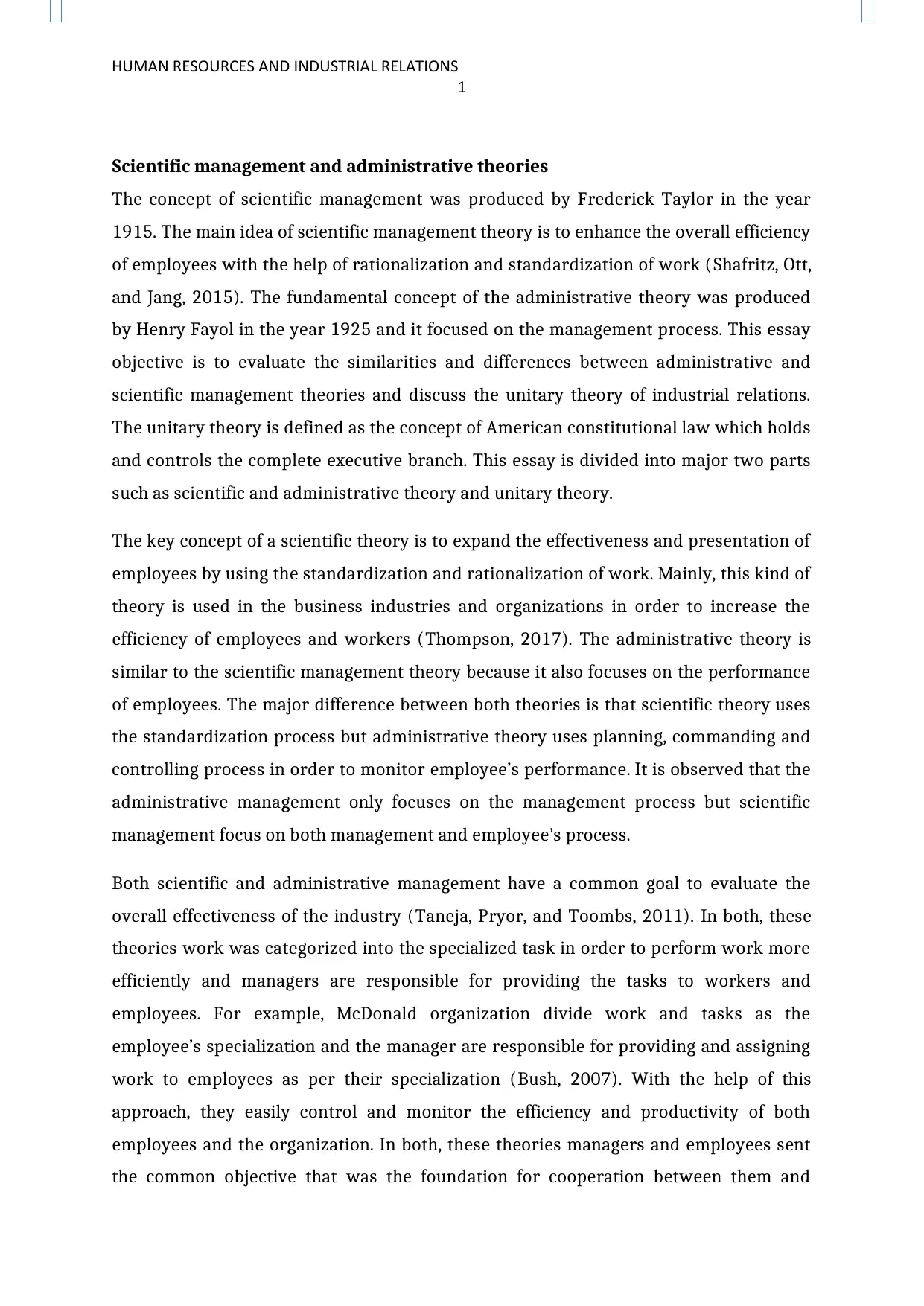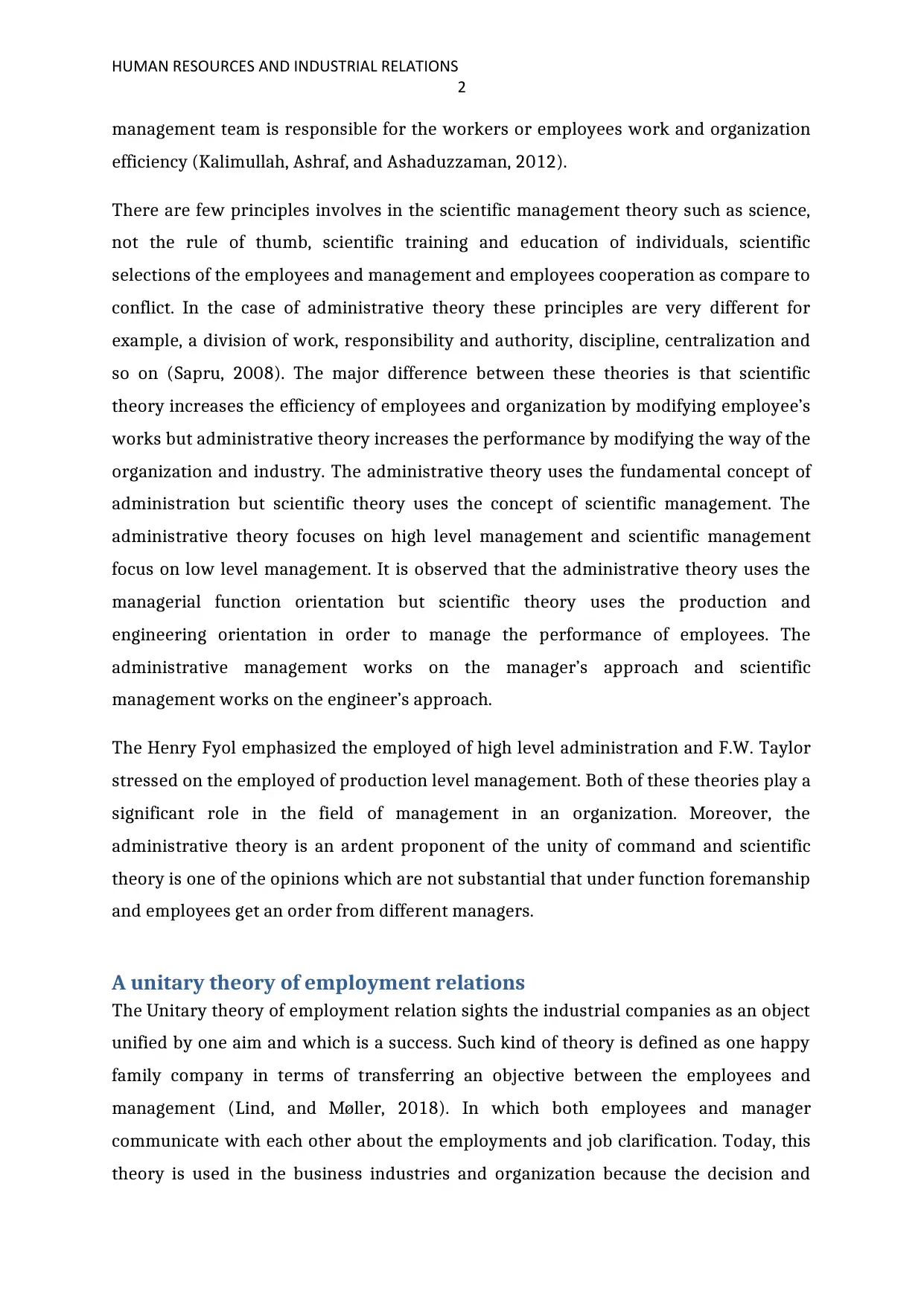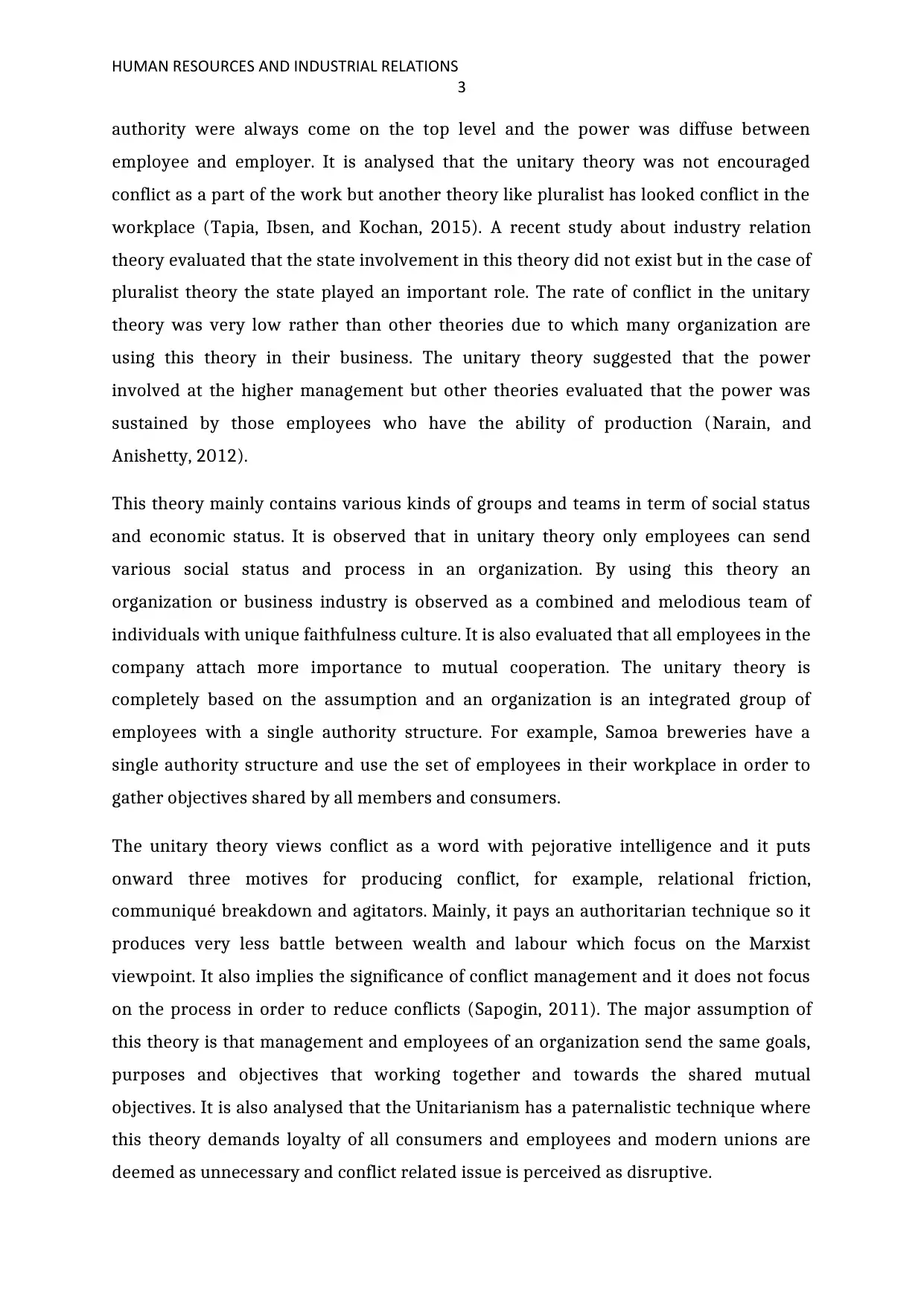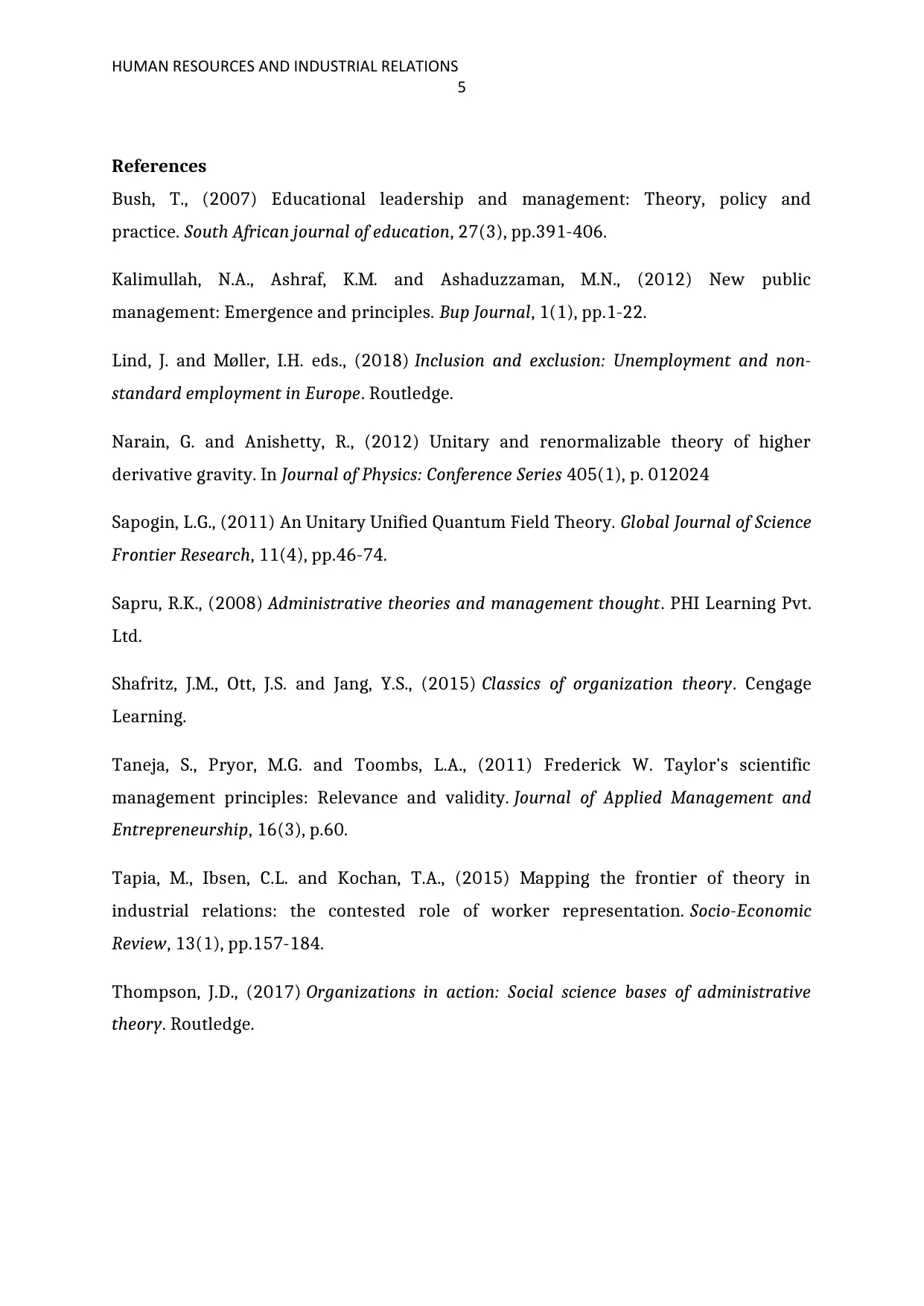Evaluation of HR and Industrial Relations Theories and Concepts
VerifiedAdded on 2023/04/21
|6
|1749
|337
Essay
AI Summary
This essay delves into the realm of Human Resources and Industrial Relations, focusing on the evaluation of key theories. It begins by outlining scientific management and administrative theories, highlighting their core concepts, such as the rationalization and standardization of work, and the emphasis on management processes. The essay then compares and contrasts these theories, emphasizing their shared goals of enhancing organizational efficiency and employee performance, while also pointing out their differences in approach. Furthermore, the essay introduces and discusses the unitary theory of industrial relations, exploring its principles and assumptions about workplace dynamics. The essay concludes by summarizing the key findings, emphasizing the relevance of these theories in modern organizations and employment relations, and their impact on overall efficiency and conflict management.

Human Resources and Industrial Relations
Paraphrase This Document
Need a fresh take? Get an instant paraphrase of this document with our AI Paraphraser

HUMAN RESOURCES AND INDUSTRIAL RELATIONS
1
Scientific management and administrative theories
The concept of scientific management was produced by Frederick Taylor in the year
1915. The main idea of scientific management theory is to enhance the overall efficiency
of employees with the help of rationalization and standardization of work (Shafritz, Ott,
and Jang, 2015). The fundamental concept of the administrative theory was produced
by Henry Fayol in the year 1925 and it focused on the management process. This essay
objective is to evaluate the similarities and differences between administrative and
scientific management theories and discuss the unitary theory of industrial relations.
The unitary theory is defined as the concept of American constitutional law which holds
and controls the complete executive branch. This essay is divided into major two parts
such as scientific and administrative theory and unitary theory.
The key concept of a scientific theory is to expand the effectiveness and presentation of
employees by using the standardization and rationalization of work. Mainly, this kind of
theory is used in the business industries and organizations in order to increase the
efficiency of employees and workers (Thompson, 2017). The administrative theory is
similar to the scientific management theory because it also focuses on the performance
of employees. The major difference between both theories is that scientific theory uses
the standardization process but administrative theory uses planning, commanding and
controlling process in order to monitor employee’s performance. It is observed that the
administrative management only focuses on the management process but scientific
management focus on both management and employee’s process.
Both scientific and administrative management have a common goal to evaluate the
overall effectiveness of the industry (Taneja, Pryor, and Toombs, 2011). In both, these
theories work was categorized into the specialized task in order to perform work more
efficiently and managers are responsible for providing the tasks to workers and
employees. For example, McDonald organization divide work and tasks as the
employee’s specialization and the manager are responsible for providing and assigning
work to employees as per their specialization (Bush, 2007). With the help of this
approach, they easily control and monitor the efficiency and productivity of both
employees and the organization. In both, these theories managers and employees sent
the common objective that was the foundation for cooperation between them and
1
Scientific management and administrative theories
The concept of scientific management was produced by Frederick Taylor in the year
1915. The main idea of scientific management theory is to enhance the overall efficiency
of employees with the help of rationalization and standardization of work (Shafritz, Ott,
and Jang, 2015). The fundamental concept of the administrative theory was produced
by Henry Fayol in the year 1925 and it focused on the management process. This essay
objective is to evaluate the similarities and differences between administrative and
scientific management theories and discuss the unitary theory of industrial relations.
The unitary theory is defined as the concept of American constitutional law which holds
and controls the complete executive branch. This essay is divided into major two parts
such as scientific and administrative theory and unitary theory.
The key concept of a scientific theory is to expand the effectiveness and presentation of
employees by using the standardization and rationalization of work. Mainly, this kind of
theory is used in the business industries and organizations in order to increase the
efficiency of employees and workers (Thompson, 2017). The administrative theory is
similar to the scientific management theory because it also focuses on the performance
of employees. The major difference between both theories is that scientific theory uses
the standardization process but administrative theory uses planning, commanding and
controlling process in order to monitor employee’s performance. It is observed that the
administrative management only focuses on the management process but scientific
management focus on both management and employee’s process.
Both scientific and administrative management have a common goal to evaluate the
overall effectiveness of the industry (Taneja, Pryor, and Toombs, 2011). In both, these
theories work was categorized into the specialized task in order to perform work more
efficiently and managers are responsible for providing the tasks to workers and
employees. For example, McDonald organization divide work and tasks as the
employee’s specialization and the manager are responsible for providing and assigning
work to employees as per their specialization (Bush, 2007). With the help of this
approach, they easily control and monitor the efficiency and productivity of both
employees and the organization. In both, these theories managers and employees sent
the common objective that was the foundation for cooperation between them and

HUMAN RESOURCES AND INDUSTRIAL RELATIONS
2
management team is responsible for the workers or employees work and organization
efficiency (Kalimullah, Ashraf, and Ashaduzzaman, 2012).
There are few principles involves in the scientific management theory such as science,
not the rule of thumb, scientific training and education of individuals, scientific
selections of the employees and management and employees cooperation as compare to
conflict. In the case of administrative theory these principles are very different for
example, a division of work, responsibility and authority, discipline, centralization and
so on (Sapru, 2008). The major difference between these theories is that scientific
theory increases the efficiency of employees and organization by modifying employee’s
works but administrative theory increases the performance by modifying the way of the
organization and industry. The administrative theory uses the fundamental concept of
administration but scientific theory uses the concept of scientific management. The
administrative theory focuses on high level management and scientific management
focus on low level management. It is observed that the administrative theory uses the
managerial function orientation but scientific theory uses the production and
engineering orientation in order to manage the performance of employees. The
administrative management works on the manager’s approach and scientific
management works on the engineer’s approach.
The Henry Fyol emphasized the employed of high level administration and F.W. Taylor
stressed on the employed of production level management. Both of these theories play a
significant role in the field of management in an organization. Moreover, the
administrative theory is an ardent proponent of the unity of command and scientific
theory is one of the opinions which are not substantial that under function foremanship
and employees get an order from different managers.
A unitary theory of employment relations
The Unitary theory of employment relation sights the industrial companies as an object
unified by one aim and which is a success. Such kind of theory is defined as one happy
family company in terms of transferring an objective between the employees and
management (Lind, and Møller, 2018). In which both employees and manager
communicate with each other about the employments and job clarification. Today, this
theory is used in the business industries and organization because the decision and
2
management team is responsible for the workers or employees work and organization
efficiency (Kalimullah, Ashraf, and Ashaduzzaman, 2012).
There are few principles involves in the scientific management theory such as science,
not the rule of thumb, scientific training and education of individuals, scientific
selections of the employees and management and employees cooperation as compare to
conflict. In the case of administrative theory these principles are very different for
example, a division of work, responsibility and authority, discipline, centralization and
so on (Sapru, 2008). The major difference between these theories is that scientific
theory increases the efficiency of employees and organization by modifying employee’s
works but administrative theory increases the performance by modifying the way of the
organization and industry. The administrative theory uses the fundamental concept of
administration but scientific theory uses the concept of scientific management. The
administrative theory focuses on high level management and scientific management
focus on low level management. It is observed that the administrative theory uses the
managerial function orientation but scientific theory uses the production and
engineering orientation in order to manage the performance of employees. The
administrative management works on the manager’s approach and scientific
management works on the engineer’s approach.
The Henry Fyol emphasized the employed of high level administration and F.W. Taylor
stressed on the employed of production level management. Both of these theories play a
significant role in the field of management in an organization. Moreover, the
administrative theory is an ardent proponent of the unity of command and scientific
theory is one of the opinions which are not substantial that under function foremanship
and employees get an order from different managers.
A unitary theory of employment relations
The Unitary theory of employment relation sights the industrial companies as an object
unified by one aim and which is a success. Such kind of theory is defined as one happy
family company in terms of transferring an objective between the employees and
management (Lind, and Møller, 2018). In which both employees and manager
communicate with each other about the employments and job clarification. Today, this
theory is used in the business industries and organization because the decision and
⊘ This is a preview!⊘
Do you want full access?
Subscribe today to unlock all pages.

Trusted by 1+ million students worldwide

HUMAN RESOURCES AND INDUSTRIAL RELATIONS
3
authority were always come on the top level and the power was diffuse between
employee and employer. It is analysed that the unitary theory was not encouraged
conflict as a part of the work but another theory like pluralist has looked conflict in the
workplace (Tapia, Ibsen, and Kochan, 2015). A recent study about industry relation
theory evaluated that the state involvement in this theory did not exist but in the case of
pluralist theory the state played an important role. The rate of conflict in the unitary
theory was very low rather than other theories due to which many organization are
using this theory in their business. The unitary theory suggested that the power
involved at the higher management but other theories evaluated that the power was
sustained by those employees who have the ability of production (Narain, and
Anishetty, 2012).
This theory mainly contains various kinds of groups and teams in term of social status
and economic status. It is observed that in unitary theory only employees can send
various social status and process in an organization. By using this theory an
organization or business industry is observed as a combined and melodious team of
individuals with unique faithfulness culture. It is also evaluated that all employees in the
company attach more importance to mutual cooperation. The unitary theory is
completely based on the assumption and an organization is an integrated group of
employees with a single authority structure. For example, Samoa breweries have a
single authority structure and use the set of employees in their workplace in order to
gather objectives shared by all members and consumers.
The unitary theory views conflict as a word with pejorative intelligence and it puts
onward three motives for producing conflict, for example, relational friction,
communiqué breakdown and agitators. Mainly, it pays an authoritarian technique so it
produces very less battle between wealth and labour which focus on the Marxist
viewpoint. It also implies the significance of conflict management and it does not focus
on the process in order to reduce conflicts (Sapogin, 2011). The major assumption of
this theory is that management and employees of an organization send the same goals,
purposes and objectives that working together and towards the shared mutual
objectives. It is also analysed that the Unitarianism has a paternalistic technique where
this theory demands loyalty of all consumers and employees and modern unions are
deemed as unnecessary and conflict related issue is perceived as disruptive.
3
authority were always come on the top level and the power was diffuse between
employee and employer. It is analysed that the unitary theory was not encouraged
conflict as a part of the work but another theory like pluralist has looked conflict in the
workplace (Tapia, Ibsen, and Kochan, 2015). A recent study about industry relation
theory evaluated that the state involvement in this theory did not exist but in the case of
pluralist theory the state played an important role. The rate of conflict in the unitary
theory was very low rather than other theories due to which many organization are
using this theory in their business. The unitary theory suggested that the power
involved at the higher management but other theories evaluated that the power was
sustained by those employees who have the ability of production (Narain, and
Anishetty, 2012).
This theory mainly contains various kinds of groups and teams in term of social status
and economic status. It is observed that in unitary theory only employees can send
various social status and process in an organization. By using this theory an
organization or business industry is observed as a combined and melodious team of
individuals with unique faithfulness culture. It is also evaluated that all employees in the
company attach more importance to mutual cooperation. The unitary theory is
completely based on the assumption and an organization is an integrated group of
employees with a single authority structure. For example, Samoa breweries have a
single authority structure and use the set of employees in their workplace in order to
gather objectives shared by all members and consumers.
The unitary theory views conflict as a word with pejorative intelligence and it puts
onward three motives for producing conflict, for example, relational friction,
communiqué breakdown and agitators. Mainly, it pays an authoritarian technique so it
produces very less battle between wealth and labour which focus on the Marxist
viewpoint. It also implies the significance of conflict management and it does not focus
on the process in order to reduce conflicts (Sapogin, 2011). The major assumption of
this theory is that management and employees of an organization send the same goals,
purposes and objectives that working together and towards the shared mutual
objectives. It is also analysed that the Unitarianism has a paternalistic technique where
this theory demands loyalty of all consumers and employees and modern unions are
deemed as unnecessary and conflict related issue is perceived as disruptive.
Paraphrase This Document
Need a fresh take? Get an instant paraphrase of this document with our AI Paraphraser

HUMAN RESOURCES AND INDUSTRIAL RELATIONS
4
This essay is completely based on the scientific management, administrative and
unitary theory and readers can gather their knowledge in the field of human resources
theories. It is concluded that both scientific and administrative theories are used in the
organization and employment relation for increasing the overall efficiency of the
organization. This essay also explained the similarities and differences between both
administrative and scientific theories of the employment relation. The key difference
between both theories is that administrative theory is used for top level management
and scientific theory is used for low level management. Above essay also argued about
the criticism of the unitary theory and many examples are also added in order to
understand and support statements. Moreover, it is concluded that the unitary theory
has less conflict rather than other theories but it does not take any serious action in
order to reduce them.
4
This essay is completely based on the scientific management, administrative and
unitary theory and readers can gather their knowledge in the field of human resources
theories. It is concluded that both scientific and administrative theories are used in the
organization and employment relation for increasing the overall efficiency of the
organization. This essay also explained the similarities and differences between both
administrative and scientific theories of the employment relation. The key difference
between both theories is that administrative theory is used for top level management
and scientific theory is used for low level management. Above essay also argued about
the criticism of the unitary theory and many examples are also added in order to
understand and support statements. Moreover, it is concluded that the unitary theory
has less conflict rather than other theories but it does not take any serious action in
order to reduce them.

HUMAN RESOURCES AND INDUSTRIAL RELATIONS
5
References
Bush, T., (2007) Educational leadership and management: Theory, policy and
practice. South African journal of education, 27(3), pp.391-406.
Kalimullah, N.A., Ashraf, K.M. and Ashaduzzaman, M.N., (2012) New public
management: Emergence and principles. Bup Journal, 1(1), pp.1-22.
Lind, J. and Møller, I.H. eds., (2018) Inclusion and exclusion: Unemployment and non-
standard employment in Europe. Routledge.
Narain, G. and Anishetty, R., (2012) Unitary and renormalizable theory of higher
derivative gravity. In Journal of Physics: Conference Series 405(1), p. 012024
Sapogin, L.G., (2011) An Unitary Unified Quantum Field Theory. Global Journal of Science
Frontier Research, 11(4), pp.46-74.
Sapru, R.K., (2008) Administrative theories and management thought. PHI Learning Pvt.
Ltd.
Shafritz, J.M., Ott, J.S. and Jang, Y.S., (2015) Classics of organization theory. Cengage
Learning.
Taneja, S., Pryor, M.G. and Toombs, L.A., (2011) Frederick W. Taylor's scientific
management principles: Relevance and validity. Journal of Applied Management and
Entrepreneurship, 16(3), p.60.
Tapia, M., Ibsen, C.L. and Kochan, T.A., (2015) Mapping the frontier of theory in
industrial relations: the contested role of worker representation. Socio-Economic
Review, 13(1), pp.157-184.
Thompson, J.D., (2017) Organizations in action: Social science bases of administrative
theory. Routledge.
5
References
Bush, T., (2007) Educational leadership and management: Theory, policy and
practice. South African journal of education, 27(3), pp.391-406.
Kalimullah, N.A., Ashraf, K.M. and Ashaduzzaman, M.N., (2012) New public
management: Emergence and principles. Bup Journal, 1(1), pp.1-22.
Lind, J. and Møller, I.H. eds., (2018) Inclusion and exclusion: Unemployment and non-
standard employment in Europe. Routledge.
Narain, G. and Anishetty, R., (2012) Unitary and renormalizable theory of higher
derivative gravity. In Journal of Physics: Conference Series 405(1), p. 012024
Sapogin, L.G., (2011) An Unitary Unified Quantum Field Theory. Global Journal of Science
Frontier Research, 11(4), pp.46-74.
Sapru, R.K., (2008) Administrative theories and management thought. PHI Learning Pvt.
Ltd.
Shafritz, J.M., Ott, J.S. and Jang, Y.S., (2015) Classics of organization theory. Cengage
Learning.
Taneja, S., Pryor, M.G. and Toombs, L.A., (2011) Frederick W. Taylor's scientific
management principles: Relevance and validity. Journal of Applied Management and
Entrepreneurship, 16(3), p.60.
Tapia, M., Ibsen, C.L. and Kochan, T.A., (2015) Mapping the frontier of theory in
industrial relations: the contested role of worker representation. Socio-Economic
Review, 13(1), pp.157-184.
Thompson, J.D., (2017) Organizations in action: Social science bases of administrative
theory. Routledge.
⊘ This is a preview!⊘
Do you want full access?
Subscribe today to unlock all pages.

Trusted by 1+ million students worldwide
1 out of 6
Related Documents
Your All-in-One AI-Powered Toolkit for Academic Success.
+13062052269
info@desklib.com
Available 24*7 on WhatsApp / Email
![[object Object]](/_next/static/media/star-bottom.7253800d.svg)
Unlock your academic potential
Copyright © 2020–2025 A2Z Services. All Rights Reserved. Developed and managed by ZUCOL.





